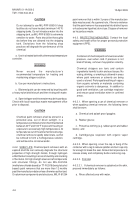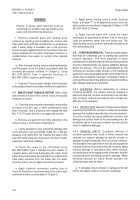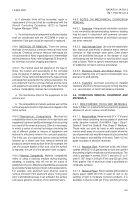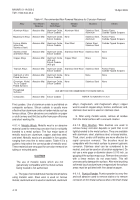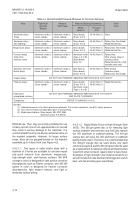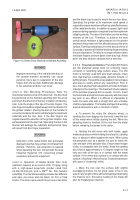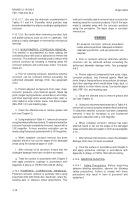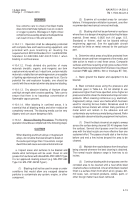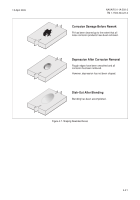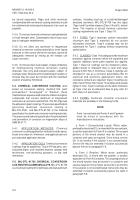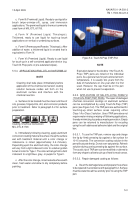TM-1-1500-344-23-2 - Page 92 of 240
4-16
NAVAIR 01-1A-509-2
TM 1-1500-344-23-2
15 April 2009
Figure 4-6. Portable Vacuum Blast Equipment
given in Table 4-4 are for direct pressure equipment. As
a general rule, increase the nozzle pressure by 50%
when using suction feed equipment.
4-9.3.1.2. Air Hoses. The nozzle pressure of the blast
stream is affected by the length and inside diameter of
the air hoses. It is best to use the shortest hose possible,
so that there will not be an excessive pressure drop. If
it is necessary to couple lengths of hose, quick connect/
disconnect external couplers are recommended.
4-9.3.1.3. Blast Nozzles. In general, larger nozzle sizes
are preferable to smaller ones, because more area can
be cleaned per hour with the same amount of labor.
High efficiency nozzles (e.g. tungsten carbide) should
be used, since they have a longer use life, require less
replacement time, and direct the blasting particles more
efficiently. Nozzles should be periodically inspected for
wear and discarded when the orifice is worn to a
diameter which is 50 percent greater than the diameter
when new. A worn nozzle, like a larger nozzle, will
require a larger volume of air flow from the compressor
to sustain the needed pressure at the nozzle.
4-9.3.1.4. Air Supply. Frictional losses in the hoses
reduce the pressure at the nozzle, and nozzle wear
increases the volume of air needed to maintain the
desired nozzle pressure. To allow for nozzle wear, it is
generally good practice to have a compressor capable
of twice the pressure required for a new nozzle. Moisture
and oil in the air stream is collected in the abrasive
during blasting operations and gradual accumulations
will cause the abrasive to clog the blaster. A water and
oil separator must be used in the compressed air supply
line to reduce excessive moisture or oil.
4-9.3.2. Portable Vacuum Blast Equipment. Also known
as a vacu-blaster or dry honing machine, these devices
Figure 4-5. Glove Box Unit Blast Cabinet
are portable machines designed to recover the abrasive
as it rebounds from the work piece. Vacu-blasters have
an abrasive hopper, a reclaimer, a dust collector, a
vacuum pump and a blast gun which contains both a
blast nozzle and a vacuum duct for recovery of the
media (Figure 4-6). This equipment is most effective on
flat or slightly curved surfaces so that the media rebounds
near the vacuum duct surrounding the blast nozzle.
Refer to NAVAIR 17-5BM-1, 17-5BM-2, and 17-5BM-3,
for Navy equipment and TM 55-1500 series manuals for
Army equipment.
4-9.3.3. Wet Abrasive Blasting. Wet blasting is a
technique using high pressure water as the medium for
the delivery of abrasives. This method is not as harmful
to the base metal as dry abrasive blasting, due to the
cushioning effect of the water medium. Unfortunately,
this effect inhibits the speed with which coatings and
corrosion products are removed. The abrasive material
is normally not recoverable in wet blasting operations,
and only sand (MIL-A-22262), aluminum oxide
(A-A-59316), or No. 13 glass beads (MIL-G-9954) shall
be used. A corrosion inhibitor solution must be added to
the water or applied to the blasted surface immediately
after blasting to give some protection from rusting until
the part can be painted.
Back to Top

